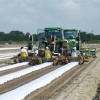 With the new fumigant regulations and rising cost of crop production, including fumigants, it would be desirable to reduce the standard use rate of soil fumigants. The use of higher-barrier, gas-impermeable mulches may make it possible to reduce fumigant application rates by helping to contain the fumigant longer within the soil and reduce overall emissions into the atmosphere. The results of field studies show that fumigant application rates can be reduced by 20 to as much as 40% through the use of virtually impermeable or the more gas-tight TIF mulch films at the time of application. This 5-page fact sheet was written by J. W. Noling, and published by the UF Department of Entomology and Nematology, March 2013.
With the new fumigant regulations and rising cost of crop production, including fumigants, it would be desirable to reduce the standard use rate of soil fumigants. The use of higher-barrier, gas-impermeable mulches may make it possible to reduce fumigant application rates by helping to contain the fumigant longer within the soil and reduce overall emissions into the atmosphere. The results of field studies show that fumigant application rates can be reduced by 20 to as much as 40% through the use of virtually impermeable or the more gas-tight TIF mulch films at the time of application. This 5-page fact sheet was written by J. W. Noling, and published by the UF Department of Entomology and Nematology, March 2013.
http://edis.ifas.ufl.edu/in403
Tag: Mulches
Eucalyptus and Corymbia Species for Pulpwood, Mulchwood, Energywood, Windbreaks, and/or Phytoremediation (CIR1194/FR013)
In Florida, Eucalyptus species grow faster than our native tree species. Certain species, when planted on suitable sites and managed properly, can produce commercial products such as pulpwood, mulchwood, and energywood, can remediate environmental problems, or may be used as windbreaks for citrus and vegetables. This circular describes potential applications and presents planting guidelines for these three species. This revised 7-page fact sheet was written by D. L. Rockwood and G. F. Peter, and published by the UF Department of School of Forest Resources and Conservation, March 2011.
http://edis.ifas.ufl.edu/fr013